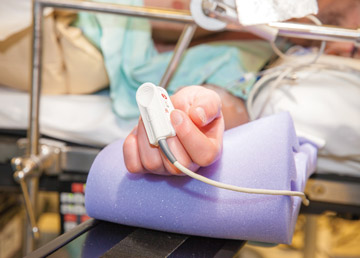The two-inch red circle on the patient's sacrum was unmistakable. A PACU nurse noticed the deep tissue injury during a post-op assessment and called over to pre-op to see if one of her colleagues had documented the patient's skin condition before surgery. No one had. The 51-year-old male patient with a BMI of 44 had undergone a left distal open reduction and internal fixation, an outpatient procedure that typically takes 90 minutes to complete, but this case had unexpectedly lasted more than three hours. All told, including time spent in pre-op, the patient was supine on a stretcher for five hours.
"We didn't have a pressure injury prevention program in place at our on-campus surgery center, so a pre-op baseline skin assessment wasn't done," says Diane Kimsey, MSN, MHA, RN, CNOR, CMLSO, WTA, perioperative educator at Einstein Medical Center Montgomery in East Norriton, Pa. "At the time, we weren't sure if the patient presented with the injury or had acquired it during surgery."
Many surgical nurses float between Einstein's inpatient ORs and its ASC, so they're familiar with the comprehensive pressure injury prevention program in place at the main hospital. "We had to determine what protocols could provide the same level of protection for patients in the ambulatory setting," says Ms. Kimsey.
She huddled with Bryan Panetta, RN, manager of the hospital's short procedure unit and operating room, and developed a straightforward pressure injury risk-reduction strategy based on a three-hour limit because "evidence shows skin can break down on patients who remain in a static position for that long," says Mr. Panetta.
- Identifying high-risk patients. The nurse who reviews charts several days before scheduled procedures flags patients with BMIs under 19 and over 40 — individuals who are obese and underweight are at increased risk for skin breakdown — and sends an email including the patients' names, dates of surgery and BMIs to Ms. Kimsey and Mr. Panetta. "We then determine if there's any possibility of the patient being on the surgical table or stretcher chair for longer than three hours," says Ms. Kimsey.
Mr. Panetta knows how long scheduled procedures should last, but also taps into his working knowledge of how the surgery center runs to help make the decision. For example, he knows cases with surgeons who are more — ahem — deliberate than their colleagues have a chance to go over the allotted time on the schedule. He's aware that distal open reduction and internal fixations —the procedure that launched the hospital's risk-reduction bundle — require instrumentation that takes a long time to set up and complex foot reconstructions can last longer than expected.
If there is little to no possibility that a patient will be on a table or stretcher chair for more than three hours, no action is taken. Patients who are expected to remain on either surface beyond the three-hour limit are placed in the risk-reduction bundle, and the perioperative team is notified about the added protection these patients require.
- Preoperatively. A green placard is placed in the charts of high-risk patients to alert pre-op nurses that they must conduct full-body assessments to look for pre-existing skin injuries and document the results in the hospital's EMR. If skin issues exist, they are assessed, dressed if applicable and documented in the EMR. High-risk patients wear a green bouffant to alert other members of the care team that steps are needed to protect the patient from harm.
- Intraoperatively. Members of the surgical team use additional care when positioning high-risk patients and apply appropriate preventative dressings and positioning devices. If patients will remain on stretcher chairs until discharge, nurses place inflatable air mattresses on the surfaces of the stretchers. If patients will be positioned on surgical tables, gel overlays are applied to the surfaces. Posters showing the pressure points for each surgical position hang in ORs for staff to reference when placing padding and silicone dressings over vulnerable areas.
- Postoperatively. OR nurses include information about potential skin issues and the precautions taken during pre-op and surgery during handoff communications with recovery nurses. In post-op, nurses offload the patient's vulnerable side, assess the skin at pressure points and document the exam's results in the EMR. They fill out and submit a patient safety report if any skin abnormalities or concerns are noted. At the time of discharge, assessments of the patient's skin condition in pre-op, the OR and post-op have been documented in the EMR.
The risk-reduction bundle's guidelines do not include thresholds for how long patients remain on stretchers in pre-op due to delayed start times. "Patients are typically in and out of that area in a timely fashion," explains Ms. Kinsley. "However, nurses are vigilant about monitoring how long patients remain in pre-op and alert us if a case's start time is delayed significantly to find out if they should shift the patient into the bundle."
.svg?sfvrsn=be606e78_3)

.svg?sfvrsn=56b2f850_5)